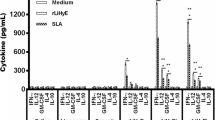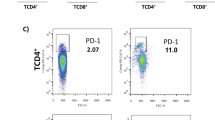Abstract
A first generation vaccine (AS100-1) was manufactured with protein from four cultured Leishmania species, which proved to be effective in the treatment of psoriasis. A single blind trial on 3,132 psoriasis patients revealed 508 (16.2%) subjects with psoriatic arthritis (PsA) that received AS100-1 antigens. The study group was distributed according to percent psoriasis area and severity index (PASI) reduction from PASI 10 to PASI 100. All groups decreased in arthritis score (AS), tender joints counts and nail changes after treatment; the highest decreased in the PASI 100 group. Relapses of psoriasis and PsA had PASI and AS lower than initial values before treatment. Clinical remissions were at lower doses and less time, after the second course of treatment. Peripheral blood mononuclear cells (PBMC) lymphocyte subsets (LS) varied with PASI range (1–10, 11–20 and 21–72). Pre-treatment, absolute values of gated LS: CD4+, CD8+HLA−, CD8+HLA+, CD8+CD3−, CD8+CD3+ decreased in PBMC as PASI increased, suggesting migration from the blood to the skin. In contrary to the previous finding, the following LS: CD8+CD4−, CD3+CD8−, HLA+CD8−, CD19, CD8+CD4+ and membrane surface immunoglobulin IgA+, IgD+, IgM+, IgE+, and IgG+ increased in PBMC as PASI increased suggesting activation and proliferation by unknown antigens creating a homeostatic cycle between skin/joints and peripheral blood. After nine doses of AS100-1, the following LS: CD8+CD3+, CD8+HLA+, CD3+CD8−, CD4+CD8−, CD8+HLA−, HLA+CD8−, CD8+CD3−, CD19+, CD8+CD4−, CD8+CD4+, IgA+, IgD+, IgM+, IgE+, and IgG+ decreased significantly as compared with values before treatment. The LS decreased stops the vicious cycle between skin/joints and blood explaining clinical remission of lesions.





Similar content being viewed by others
References
Amherd-Hoekstra A, Näher H, Lorenz HM et al (2010) Psoriatic arthritis: a review. J Dtsch Dermatol Ges 8:332–339
Barton AC (2002) Genetic epidemiology. Psoriatic arthritis. Arthritis Res 4:247–251
Boyle DL, Kavanaugh A (2008) The pathobiology of psoriatic synovium. Curr Opin Rheumatol 20:404–407
Brewer JM (2006) (How) do aluminium adjuvants work? Immunol Lett 102:10–15
Brockbank JE, Stein M, Schentag CT et al (2005) Dactylitis in psoriatic arthritis: a marker for disease severity? Ann Rheum Dis 64:188–190
Cassell SE, Bieber JD, Rich P et al (2007) The modified nail psoriasis severity index: validation of an instrument to assess psoriatic nail involvement in patients with psoriatic arthritis. J Rheumatol 2007 34:123–129
Ceponis A, Kavanaugh A (2010) Treatment of psoriatic arthritis with biological agents. Semin Cutan Med Surg 29:56–62
Chandran V, Gottlieb A, Cook RJ et al (2009) Psoriatic arthritis international multicenter psoriasis and psoriatic arthritis reliability trial for the assessment of skin, joints, nails, and dactylitis. Arthritis Rheum 61:1235–1242
Chandran V, Raychaudhuri SP (2010) Geoepidemiology and environmental factors of psoriasis and psoriatic arthritis. J Autoimmun 34:314–321
Chandran V, Schentag CT, Gladman DD (2007) Sensitivity of the classification of psoriatic arthritis criteria in early psoriatic arthritis. Arthritis Rheum 57:1560–1563
Chang YT, Chen TJ, Liu PC et al (2009) Epidemiological study of psoriasis in the national health insurance database in Taiwan. Acta Derm Venereol 89:262–266
Choy E (2007) T cells in psoriatic arthritis. Curr Rheumatol Rep 9:437–441
Choy MK, Phipps ME (2010) MICA polymorphism: biology and importance in immunity and disease. Trends Mol Med 16:97–106
Christophers E, Barker JN, Griffiths CE et al (2010) The risk of psoriatic arthritis remains constant following initial diagnosis of psoriasis among patients seen in European dermatology clinics. J Eur Acad Dermatol Venereol 24:548–554
Ciocon DH, Kimball AB (2007) Psoriasis and psoriatic arthritis: separate or one and the same? Br J Dermatol 157:850–860
Coates LC, Helliwell PS (2008) Classification and categorization of psoriatic arthritis. Clin Rheumatol 27:1211–1216
Costello P, Bresnihan B, O’Farrelly C et al (1999) Predominance of CD8+ T lymphocytes in psoriatic arthritis. J Rheumatol 26:1117–1124
Elder JT (2009) Genome-wide association scan yields new insights into the immunopathogenesis of psoriasis. Genes Immun 10:201–209
Englbrecht M, Wang Y, Ronneberger M et al (2010) Measuring joint involvement in polyarticular psoriatic arthritis: an introduction of alternatives. Arthritis Care Res 62:977–983
Filaci G, Fenoglio D, Indiveri F (2011) CD8(+) T regulatory/suppressor cells and their relationships with autoreactivity and autoimmunity. Autoimmunity 44:51–57
Filaci G, Rizzi M, Setti M et al (2005) Non-antigen-specific CD8(+) T suppressor lymphocytes in diseases characterized by chronic immune responses and inflammation. Ann N Y Acad Sci 1050:115–123
Fink AM, Cauza E, Hassfeld W et al (2007) Vascular endothelial growth factor in patients with psoriatic arthritis. Clin Exp Rheumatol 25:305–308
FitzGerald O, Winchester R (2009) Psoriatic arthritis: from pathogenesis to therapy. Arthritis Res Ther 11:214–223
Gabriel SE, Michaud K (2009) Epidemiological studies in incidence, prevalence, mortality, and comorbidity of the rheumatic diseases. Arthritis Res Ther 11:229–245
González S, Martínez-Borra J, López-Vázquez A et al (2002) MICA rather than MICB, TNFA, or HLA-DRB1 is associated with susceptibility to psoriatic arthritis. J Rheumatol 29:973–978
Griffiths EMG, Barker JN (2007) Pathogenesis and clinical features of psoriasis. Lancet 370:263–271
Ibrahim G, Waxman R, Helliwell PS (2009) The prevalence of psoriatic arthritis in people with psoriasis. Arthritis Rheum 61:1373–1378
Jandus C, Bioley G, Rivals JP et al (2008) Increased numbers of circulating polyfunctional Th17 memory cells in patients with seronegative spondylarthritides. Arthritis Rheum 58:2307–2317
Kemp M, Hansen MB, Theander TG (1992) Recognition of Leishmania antigens by T lymphocytes from nonexposed individuals. Infect Immun 60:2246–2251
Lowry OH, Rosebrough NJ, Farr AL, Randall RJ (1951) Protein measurement with the folin phenol reagent. J Biol Chem 193(1):265–275
Maciejewska H, Jüngel A, Gay RE et al (2009) Innate immunity, epigenetics and autoimmunity in rheumatoid arthritis. Mol Immunol 47:12–18
McGonagle D, Lories RJU, Tan AL et al (2007) The concept of a “synovio-entheseal complex” and its implications for understanding joint inflammation and damage in psoriatic arthritis and beyond. Arthritis Rheum 56:2482–2491
McGonagle D (2009) Enthesitis: an autoinflammatory lesion linking nail and joint involvement in psoriatic disease. J Eur Acad Dermatol Venereol 23:9–13
Mease P (2006) Psoriatic arthritis update. Bull NYU Hosp Jt Dis 64:25–31
Mease PJ (2010) Psoriatic arthritis: pharmacotherapy update. Curr Rheumatol Rep 12:272–280
Mrowietz U, Reich K (2009) Psoriasis—new insights into pathogenesis and treatment. Dtsch Arztebl Int 106:11–19
Mrowietz U, Elder JT, Barker J (2007) The importance of disease associations and concomitant therapy for the long term management of psoriasis patients. Arch Dermatol Res 298:309–319
O’Daly JA, Gleason J (2010) Antigens from Leishmania amastigotes inducing clinical remission of psoriasis: relationship between leishmaniasis and psoriasis. DERMA 1:47–57
O’Daly JA, Gleason JP, Peña G et al (2010) Purified proteins from leishmania amastigotes-induced delayed type hypersensitivity reactions and remission of collagen-induced arthritis in animal models. Arch Dermatol Res 302:567–581
O’Daly JA, Lezama R, Gleason J (2009) Isolation of Leishmania amastigote protein fractions which induced lymphocyte stimulation and remission of psoriasis. Arch Dermatol Res 301:411–427
O’Daly JA, Lezama R, Rodriguez PJ et al (2009) Antigens from Leishmania amastigotes induced clinical remission of psoriasis. Arch Dermatol Res 301:1–13
O’Daly JA, Rodriguez B, Ovalles T et al (2010) Lymphocyte subsets in peripheral blood of patients with psoriasis before and after treatment with leishmania antigens. Arch Dermatol Res 302:95–104
O’Daly JA, Rodriguez MB (1988) Differential growth requirements of several leishmania spp in chemically defined culture media. Acta Trop Basel 45:109–126
Radtke MA, Reich K, Blome C et al (2009) Prevalence and clinical features of psoriatic arthritis and joint complaints in patients with psoriasis: results of a German national survey. J Eur Acad Dermatol Venereol 23:683–691
Rajesh R, Moudgil KD (2009) Heat-shock proteins can promote as well as regulate autoimmunity. Autoimmun Rev 8:388–393
Reich K, Kruger K, Mossner R et al (2009) Epidemiology and clinical pattern of psoriatic arthritis in Germany: a prospective interdisciplinary epidemiological study of 1511 patients with plaque-type psoriasis. Br J Dermatol 160:1040–1047
Rimaniol AC, Gras G, Clayette P (2007) In vitro interactions between macrophages and aluminum-containing adjuvants. Vaccine 25:6784–6792
Rimaniol AC, Gras G, Verdier F et al (2004) Aluminum hydroxide adjuvant induces macrophage differentiation towards a specialized antigen-presenting cell type. Vaccine 22:3127–3135
Rozenblit M, Lebwohl M (2009) New biologics for psoriasis and psoriatic arthritis. Dermatol Ther 22:56–60
Saber TP, Ng CT, Renard G et al (2010) Remission in psoriatic arthritis: is it possible and how can it be predicted? Arthritis Res Ther 12:R94
Sala P, Tonutti E, Feruglio C et al (1993) Persistent expansions of CD4+ CD8+ peripheral blood T cells. Blood 82:1546–1552
Salliot C, Dernis E, Lavie F et al (2009) Diagnosis of peripheral psoriatic arthritis: recommendations for clinical practice based on data from the literature and experts opinion. Joint Bone Spine Joint Bone Spine 76:532–539
Smith PK, Krohn RI, Hermanson GT et al (1985) Measurement of protein using bicinchoninic acid. Anal Biochem 150:76–85
Soriano ER, Rosa J (2009) Update on the treatment of peripheral arthritis in psoriatic arthritis. Curr Rheumatol Rep 11:270–277
Taylor W, Gladman D, Helliwell P et al (2006) Classification criteria for psoriatic arthritis: development of new criteria from a large international study. Arthritis Rheum 54:2665–2673
Tonui WK, Mejia JS, Hochberg L et al (2004) Immunization with Leishmania major exogenous antigens protects susceptible BALB/c mice against challenge infection with L major. Infect Immun 72:5654–5661
Trautmann A, Rückert B, Schmid-Grendelmeier P et al (2003) Human CD8 T cells of the peripheral blood contain a low CD8 expressing cytotoxic/effector subpopulation. Immunology 108:305–312
Ulanova M, Tarkowski A, Hahn-Zoric M et al (2001) The common vaccine adjuvant aluminum hydroxide up-regulates accessory properties of human monocytes via an interleukin-4-dependent mechanism. Infect Immun 69:1151–1159
van Kuijk AW, Reinders-Blankert P, Smeets TJ et al (2006) Detailed analysis of the cell infiltrate and the expression of mediators of synovial inflammation and joint destruction in the synovium of patients with psoriatic arthritis: implications for treatment. Ann Rheum Dis 65:1551–1557
Weger W (2010) Current status and new developments in the treatment of psoriasis and psoriatic arthritis with biological agents. Br J Pharmacol 160:810–820
Winchester R, Minevich G, Kane D et al (2008) Heterogeneity of the psoriasis phenotype revealed by HLA class I haplotype associations in psoriatic arthritis and psoriasis. Clin Immunol 127:S88–S89
Winchester R (2004) The genetics of autoimmune-mediated rheumatic diseases: clinical and biologic implications. Rheum Dis Clin North Am 30:213–227
Wollina U, Unger L, Heinig B, Kittner T (2010) Psoriatic arthritis. Dermatol Ther 23:123–136
Zügel U, Kaufmann SHE (1999) Role of heat shock proteins in protection from and pathogenesis of infectious diseases. Clin Microbiol Rev 12:19–39
Acknowledgments
Jose A. O’Daly, Astralis CSO, CEO and Chairman, would also like to thank The Technology Business Tax Certificate Transfer Program of the Greater State of New Jersey, Economic Development Authority (eda) and to the Consejo Nacional de Investigaciones Cientificas y Tecnologicas (CONICIT) for its support, under contract # RP-IV-120030, while Dr. O’Daly was in Caracas, Venezuela.
Author information
Authors and Affiliations
Corresponding author
Rights and permissions
About this article
Cite this article
O’Daly, J.A., Gleason, J., Lezama, R. et al. Antigens from Leishmania amastigotes inducing clinical remission of psoriatic arthritis. Arch Dermatol Res 303, 399–415 (2011). https://doi.org/10.1007/s00403-011-1133-0
Received:
Revised:
Accepted:
Published:
Issue Date:
DOI: https://doi.org/10.1007/s00403-011-1133-0




